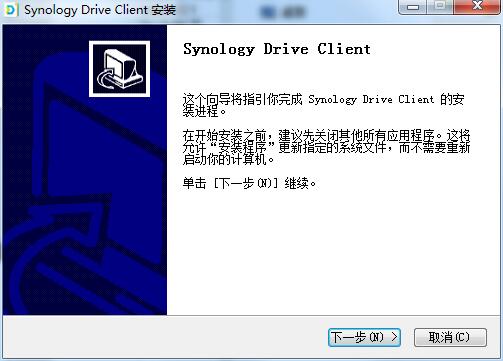

Synology drive client setup upgrade#
However, having 2GB fixed inside the system and only allowing a single upgrade slot results in a system only supporting 6 GB when the CPU inside the DS224+ actually supports up to a maximum 8GB. On the one hand, it’s nice that you can upgrade the memory on this device to allow you to do more things at any given time. This can be upgraded to a slightly unusual 6 GB of memory by installing an official DDR4 Synology SODIMM upgrade. In terms of memory, the system arrives with 2GB of DDR4 memory already pre-installed and soldered to the board. Synology has always been a brand that has been unashamedly software-focused and the hardware has simply been a case of finding the most power-efficient hardware to achieve its lofty goals, but nevertheless, users who have been holding out for a newer generation to buy may find the hardware just a little bit underwhelming.

Indeed, with more affordable Intel Pentium processors like the N6005 and Intel Celeron N5105 extremely commonplace from other competitor brands, this CPU is definitely going to seem like something of a damp squib when people are weighing up the hardware. However, there’s no avoiding that this 2019 released processor has now been featured in Synology systems for four years and although what we are seeing here is a prosumer processor now being made available in the lower home tier (not the first time Synology has done this with their portfolio between generations), there is still going to be a percentage of users who will be disappointed that some of the several newer Intel Celeron releases were not featured here. Synology ModelĢ (with Link Aggregation / Failover support) It is a decent little processor that balances a good price point versus great capabilities and is one that Synology has spent a lot of time optimizing in DSM. This quad-core, four-thread, integrated graphics-equipped processor was already a popular choice in other releases such as the Synology DS920+ and DS720+, as well as in more recent releases such as the DS423+ and DVA1622. The main focus has to be the new CPU inside the Synology DS224+, which is the already frequently featured Intel Celeron J4125 processor. We’re seeing the use of the same external chassis, same memory amount and scalability, nearly identical ports and connections, and overall, what seems like small tweaks and realignments of Synology’s portfolio here.

In terms of hardware, those who are already familiar with the DS220+ are going to struggle to see many differences here. When I mentioned earlier that the Synology DS224+ is utilizing a similar hardware architecture to its predecessor, I was not joking. Synology DS224+ NAS Hardware Specifications Let’s discuss the new Synology DS224+ and help you decide whether it deserves your data. However, we are still seeing a setup here that the brand has rigorously invested time and development into, which likely means you are getting a superior experience that is more felt than seen compared with its predecessor. I am not going to sugarcoat it, the DS224+ is by no means a significant upgrade over its predecessor and for some, it’s not going to seem like much has changed in the three years between these releases. The DS224+ is likely one of the last Synology home and SMB solutions we will see refreshed this year, as Synology clearly begins to set its sights on some of its larger and more centrally business-focused solutions in the 2024 range. Although arguably featuring very small updates in Synology’s 2024 refresh, it does boast an improved CPU, which will result in greater performance on Synology’s award-winning DSM platform.
Synology drive client setup update#
The Synology DS224+ is the update of the three-year-old DS220+ NAS, arriving in a similar framework as its predecessor. Synology has really been churning out the DiskStation releases this year, with a number of their popular DiskStation NAS devices all seeing a modern refresh to a greater or lesser degree. 9.2 Related The Synology DS224+ NAS – Coming Soon!


 0 kommentar(er)
0 kommentar(er)
